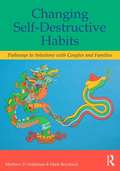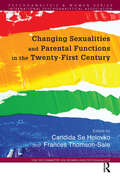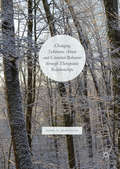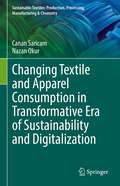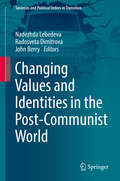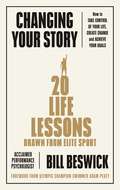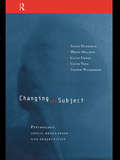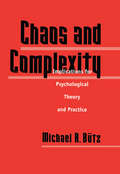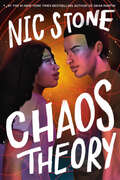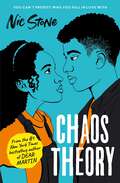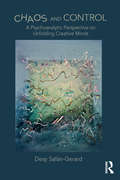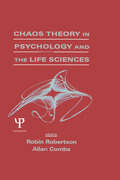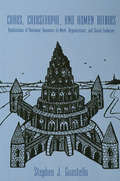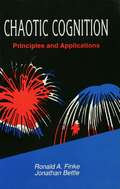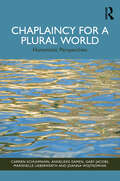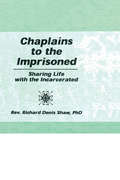- Table View
- List View
Changing Self-Destructive Habits: Pathways to Solutions with Couples and Families
by Matthew D. Selekman Mark BeyebachFor the first time in one volume self-harm, substance abuse, eating-disordered behavior, gambling, and Internet and cyber sex abuse--five crippling, self-destructive behaviors--are given a common conceptual framework to help with therapeutic intervention. Matthew Selekman and Mark Beyebach, two internationally-recognized therapists, know first-hand that therapists see clients who have problems with several of these habits in varying contexts. They maintain an optimistic, positive, solution-focused approach while carefully addressing problems and risks. The difficulties of change, the risk of slips and relapses, and the ups-and-downs of therapeutic processes are widely acknowledged and addressed. Readers will find useful, hands-on therapeutic strategies and techniques that they can use in both individual and conjoint sessions during couple, family, and one-on-one therapy. Detailed case examples provide windows to therapeutic processes and the complexities in these cases. Clinical interventions are put in a wider research context, while research is reviewed and used to extract key implications of empirical findings. This allows for a flexible and open therapeutic approach that therapists can use to integrate techniques and procedures from a variety of approaches and intervention programs.
Changing Self-Destructive Habits: Pathways to Solutions with Couples and Families
by Matthew D. Selekman Mark BeyebachFor the first time in one volume self-harm, substance abuse, eating-disordered behavior, gambling, and Internet and cyber sex abuse—five crippling, self-destructive behaviors—are given a common conceptual framework to help with therapeutic intervention. Matthew Selekman and Mark Beyebach, two internationally-recognized therapists, know first-hand that therapists see clients who have problems with several of these habits in varying contexts. They maintain an optimistic, positive, solution-focused approach while carefully addressing problems and risks. The difficulties of change, the risk of slips and relapses, and the ups-and-downs of therapeutic processes are widely acknowledged and addressed. Readers will find useful, hands-on therapeutic strategies and techniques that they can use in both individual and conjoint sessions during couple, family, and one-on-one therapy. Detailed case examples provide windows to therapeutic processes and the complexities in these cases. Clinical interventions are put in a wider research context, while research is reviewed and used to extract key implications of empirical findings. This allows for a flexible and open therapeutic approach that therapists can use to integrate techniques and procedures from a variety of approaches and intervention programs.
Changing Sexualities and Parental Functions in the Twenty-First Century: Changing Sexualities, Changing Parental Functions (Psychoanalysis and Women Series)
by Candida Se HolovkoRecent societal changes have challenged long-established concepts in psychoanalysis, including the Oedipus complex, parental functions, and male and female psychosexuality. 'Postmodern families', based on sexual and emotional exchanges independent of gender, now include homoerotic couples who adopt children, or who create them through assisted fertilisation, as well as single parent families and blended families. A number of highly-renowned Latin American psychoanalysts have drawn attention to the urgency of revising theoretical and clinical concepts in the light of these new scenarios. In this book, they open up ideas which cover familiar territory of current concerns in psychoanalytic work, as well as other little-explored areas, with the emphasis on evolving sexualities and new experiences of parenthood. The first section revisits psychoanalytic theories, particularly parental functions in the area of sexuality and gender. The following section discusses new family configurations, and vicissitudes of the desire to have a child in men and women, with the authors presenting some psychic consequences for parents in therapy who have turned to assisted fertilisation.
Changing Substance Abuse and Criminal Behavior Through Therapeutic Relationships
by Debra H. BenvenisteThis book approaches the treatment process from a new andyet old perspective. Eleven men who successfully desisted from substance abuseand offending were interviewed to determine how their significant therapeuticrelationships facilitated this life change. Data is integrated with a newpsychodynamic framework, relational analytic theory, which focuses clinicalattention on the qualities and processes of the therapeutic relationship. Atherapy model is developed which addresses how to attain and maintaintherapeutic engagement, treat client symptoms, and utilize therapeutic conflictto develop client capacity for internal conflict and personal agency, functionscritical to resolving addictive behavior. Societal and cultural obstacles totreatment are addressed including group stigmatisation, a lack of funding, and ourcurrent manual and group-based treatment protocols.
Changing Textile and Apparel Consumption in Transformative Era of Sustainability and Digitalization (Sustainable Textiles: Production, Processing, Manufacturing & Chemistry)
by Canan Saricam Nazan OkurThis monograph describes emerging practices of sustainability and digitalization in the fashion industry and the consumer perspectives on implementation efforts. The chapters in the book are organized into three parts. In the first part of each chapter, a general overview of the topic is given with the relevant descriptions, information, facts, and statistics. The second section of each chapter provides cases and consumer perspectives. Each chapter ends with an empirical study. The chapters discuss practical implications for the professionals as well as findings associated with different consumer groups. The contents of this book will be useful to both academics and practitioners.
Changing Values and Identities in the Post-Communist World (Societies And Political Orders In Transition Ser.)
by John Berry Radosveta Dimitrova Nadezhda LebedevaThis book offers a comparative analysis of value and identity changes in several post-Soviet countries. In light of the tremendous economic, social and political changes in former communist states, the authors compare the values, attitudes and identities of different generations and cultural groups. Based on extensive empirical data, using quantitative and qualitative methods to study complex social identities, this book examines how intergenerational value and identity changes are linked to socio-economic and political development. Topics include the rise of nationalist sentiments, identity formation of ethnic and religious groups and minorities, youth identity formation and intergenerational value conflicts.
Changing Your Story: How To Take Control Of Your Life, Create Change And Achieve Your Goals
by Bill Beswick'Bill offers you an opportunity to grow your mind and think like a champion. I recommend it to you!' Adam Peaty******We all love stories. They make us feel, help us connect, relate to one another, and make sense of our lives. Bill Beswick is a storyteller who has 20 powerful life lessons to share from his work with his clients at the top of their fieldsto help us all overcome our fears, boost our performance and achieve success. Leading sports and performance psychologist, Bill Beswick, sees sport as a story of human connection. When faced with physical challenges, pressure and fatigue, the mind is the athlete and the body is simply the means. With an exclusive foreword written by British gold-medal Olympian Adam Peaty, Changing Your Story explores how the way we think and feel is vital for releasing positive energy and improving our performance. Beswick's 20 lessons will bestow resilience and guide you through the process of harnessing the full power of your physical abilities. This is a book about change. Bill Beswick's advice is guaranteed to equip you with new, more efficient ways to think. Through his powerful storytelling, he will help you let go of a negative mind-set and embrace a much stronger, positive and determined one. Anything is possible when you realise it's never too late to switch direction and change your story.
Changing for Good: A Revolutionary Six-Stage Program for Overcoming Bad Habits and Moving Your Life Positively Forward
by James O. Prochaska John C. Norcross Carlo C. DiclementeHow many times have you thought about starting a diet or quitting smoking without doing anything about it? Or lapsed back into bad habits after hitting a rough spot on the road to recovery? To uncover the secret to successful personal change, three acclaimed psychologists studied more than 1000 people who were able to positively and permanently alter their lives without psychotherapy. They discovered that change does not depend on luck or willpower. It is a process that can be successfully managed by anyone who understands how it works. Once you determine which stage of change you're in, you can: * create a climate where positive change can occur * maintain motivation * turn setbacks into progress * make your new beneficial habits a permanent part of your life This groundbreaking book offers simple self-assessments, informative case histories, and concrete examples to help clarify each stage and process. Whether your goal is to start saving money, to stop drinking, or to end other self-defeating or addictive behaviors, this revolutionary program will help you implement positive personal change . . . for life.
Changing the Conversation: The 17 Principles of Conflict Resolution
by Joost Elffers Dana CaspersenThe seventeen key principles for transforming conflict—in a beautiful package from the creator of The 48 Laws of Power From Joost Elffers, the packaging genius behind the huge New York Times bestsellers The 48 Laws of Power, The 33 Strategies of War, and The Art of Seduction, comes this invaluable manual that teaches seventeen fundamentals for turning any conflict into an opportunity for growth. Beautifully packaged in a graphic, two-color format, Changing the Conversation is written by conflict expert Dana Caspersen and is filled with real-life examples, spot-on advice, and easy-to-grasp exercises that demonstrate transformative ways to break out of destructive patterns, to create useful dialogue in difficult situations, and to find long-lasting solutions for conflicts. Sure to claim its place next to Getting to Yes, this guide will be a go-to resource for resolving conflicts.
Changing the Game: The Parent's Guide to Raising Happy, High-Performing Athletes and Giving Youth Sports Back to Our Kids
by John O'SullivanPERPERience to take us behind the scenes of competitive youth sports, and demonstrates how they have changed from being a fun pastime to an ultra competitive, adult centered enterprise that is failing our children.
Changing the Subject: Psychology, Social Regulation and Subjectivity
by Wendy Hollway Valerie Walkerdine Couze Venn Julian Henriques Cathy UrwinChanging the Subject is a classic critique of traditional psychology in which the foundations of critical and feminist psychology are laid down. Pioneering and foundational, it is still the groundbreaking text crucial to furthering the new psychology in both teaching and research. Now reissued with a new foreword describing the changes which have taken place over the last few years, Changing the Subject will continue to have a significant impact on thinking about psychology and social theory.
Changing the Way We Die
by Sheila Himmel Joan Halifax Fran SmithThere's a quiet revolution happening in the way we die. More than 1.5 million Americans a year die in hospice care-nearly 44 percent of all deaths-and a vast industry has sprung up to meet the growing demand. Once viewed as a New Age indulgence, hospice is now a $14 billion business and one of the most successful segments in health care. Changing the Way We Die, by award-winning journalists Fran Smith and Sheila Himmel, is the first book to take a broad, penetrating look at the hospice landscape, through gripping stories of real patients, families, and doctors, as well as the corporate giants that increasingly own the market.Changing the Way We Die is a vital resource for anyone who wants to be prepared to face life's most challenging and universal event. You will learn:- Hospice use is soaring, yet most people come too late to get the full benefits.- With the age tsunami, it becomes even more critical for families and patients to choose end-of-life care wisely.- Hospice at its best is much more than a way to relieve the suffering of dying. It is a way to live.
Changing the Way We Die: Compassionate End of Life Care and The Hospice Movement
by Fran SmithThere's a quiet revolution happening in the way we die. More than 1.5 million Americans a year die in hospice care--nearly 44 percent of all deaths--and a vast industry has sprung up to meet the growing demand. Once viewed as a New Age indulgence, hospice is now a $14 billion business and one of the most successful segments in health care. Changing the Way We Die, by award-winning journalists Fran Smith and Sheila Himmel, is the first book to take a broad, penetrating look at the hospice landscape, through gripping stories of real patients, families, and doctors, as well as the corporate giants that increasingly own the market. Changing the Way We Die is a vital resource for anyone who wants to be prepared to face life's most challenging and universal event. You will learn: -- Hospice use is soaring, yet most people come too late to get the full benefits. -- With the age tsunami, it becomes even more critical for families and patients to choose end-of-life care wisely. -- Hospice at its best is much more than a way to relieve the suffering of dying. It is a way to live.
Chaos And Complexity: Implications For Psychological Theory And Practice (Wiley Series In Couples And Family Dynamics And Treatment Ser. #2)
by Michael R. ButzThe nature of this book is to emphasize the inherent complexity and richness of the human experience of change. Now, the author believes there to be an acceptable "scientific" explanation for this phenomona. Explored here are 30 years of studies to describe nonlinear dynamics, today termed either chaos theory or complexity theory. The connotations of both theories are discussed at length. Offering social scientists validation in their attempts to describe and define phenomona of a previously ineffable nature, this book explores chaos' implications for psychology and the social sciences. It describes the benefits psychology can glean from using ideas in chaos theory and applying them to psychology in general, individual psycho-therapy, couples therapy, and community psychology, and also considers possible directions for research and application.
Chaos Theory
by Nic Stonehe #1 New York Times bestselling author of Dear Martin delivers a gripping romance about two teens: a certified genius living with a diagnosed mental disorder and a politician’s son who is running from his own addiction and grief. Don’t miss this gut punch of a novel about mental health, loss, and discovering you are worthy of love. <p><p> Scars exist to remind us of what we’ve survived. <p><p> DETACHED <p>Since Shelbi enrolled at Windward Academy as a senior and won’t be there very long, she hasn’t bothered making friends. What her classmates don’t know about her can’t be used to hurt her—you know, like it did at her last school. <p><p> WASTED <p>Andy Criddle is not okay. At all. <p>He’s had far too much to drink. <p>Again. Which is bad. <p>And things are about to get worse. <p><p> When Shelbi sees Andy at his lowest, she can relate. So she doesn’t resist reaching out. And there’s no doubt their connection has them both seeing stars . . . but the closer they get, the more the past threatens to pull their universes apart. <p><p> #1 New York Times bestselling author Nic Stone delivers a tour de force about living with grief, prioritizing mental health, and finding love amid the chaos.
Chaos Theory: The brand-new novel from the bestselling author of Dear Martin
by Nic StoneThe #1 New York Times bestselling author of Dear Martin delivers a gripping romance about two teens: a certified genius living with a diagnosed mental illness and a politician's son who is running from his own addiction and grief. Don't miss this gut punch of a novel about mental illness, loss, and discovering you are worthy of love. The next read for fans of Angie Thomas, Danielle Jawando and Jason ReynoldsScars exist to remind us of what we&’ve survived . . . Since Shelbi enrolled at Windward Academy as a senior and won&’t be there very long, she hasn&’t bothered making friends. What her classmates don&’t know about her can&’t be used to hurt her – you know, like it did at her last school. Andy Criddle is not okay. At all. He&’s had far too much to drink. Again. Which is bad. And things are about to get worse. When Shelbi sees Andy at his lowest, she can relate. So she doesn&’t resist reaching out. And there&’s no doubt their connection has them both seeing stars . . . but the closer they get, the more the past threatens to pull their universes apart. #1 New York Times bestselling author Nic Stone delivers a tour de force about living with grief, prioritizing mental health, and finding love amid the chaos. Praise for Dear Martin: "Powerful, wrenching" John Green "A must-read" Angie Thomas "Raw and Gripping" Jason Reynolds "Deeply moving" Jodi Picoult Also by Nic Stone:Dear Martin Odd One Out JackpotDear Justyce
Chaos and Complexity in Psychology
by Stephen J. Guastello Matthijs Koopmans David Pincus Stephen J. Guastello Matthijs KoopmansWhile many books have discussed methodological advances in nonlinear dynamical systems theory (NDS), this volume is unique in its focus on NDS's role in the development of psychological theory. After an introductory chapter covering the fundamentals of chaos, complexity, and other nonlinear dynamics, subsequent chapters provide in-depth coverage of each of the specific topic areas in psychology. A concluding chapter takes stock of the field as a whole, evaluating important challenges for the immediate future. The chapters are written by experts in the use of NDS in each of their respective areas, including biological, cognitive, developmental, social, organizational, and clinical psychology. Each chapter provides an in-depth examination of theoretical foundations and specific applications and a review of relevant methods. This edited collection represents the state of the art in NDS science across the disciplines of psychology.
Chaos and Control: A Psychoanalytic Perspective on Unfolding Creative Minds
by Desy Safan-GerardThis book explores the role of chaos and control in the creative process as well as the difference between talent and creativity. Part One describes explores some of the common biases and pitfalls in the analysis and therapy of creative people, the role of the accidental in creative work, the nature of creative blocks, passion and its absence, as well as the problem of being able to exercise one's freedom. The author describes the special needs of creative patients, the common problems arising in therapy, its solutions, and, most importantly, the analyst's distinctive role when dealing with such patients. She also probes into the role of narcissism, neurosis, and psychosis on creative work.
Chaos and Order in the World of the Psyche (Psychology Revivals)
by Joanne Wieland-Burston‘I don’t know what’s the matter with me – everything’s upside down; the whole world seems chaotic’ Chaos may erupt in our lives in many different ways – through death, divorce, conflict with family, friends or colleagues. It is a frightening and negative experience, destabilizing the individual and provoking feelings of insecurity. Originally published in English in 1992, the author, through her work as a Jungian analyst, frequently acted as a companion, support and guide to those whose lives were in chaotic turmoil. She describes how therapy helps people to meet chaos, to accept and see it in a different way – as a starting point for a new kind of order in their lives. This ‘organic’ order is better suited to their own personal needs and personality and provides the strong and flexible basis necessary to meet the chaos that belongs to life. Drawing upon the myths, tales and rites of ancient cultures, upon modern chaos theory, and upon her experience as an analyst the author shows the way through the chaos to a fuller, happier and more satisfying life.
Chaos theory in Psychology and the Life Sciences
by Robin Robertson Allan CombsThis book represents the best of the first three years of the Society for Chaos Theory in Psychology conferences. While chaos theory has been a topic of considerable interest in the physical and biological sciences, its applications in psychology and related fields have been obscured until recently by its complexity. Nevertheless, a small but rapidly growing community of psychologists, neurobiologists, sociologists, mathematicians, and philosophers have been coming together to discuss its implications and explore its research possibilities. Chaos theory has been termed the first authentic paradigm shift since the advent of quantum physics. Whether this is true or not, it unquestionably bears profound implications for many fields of thought. These include the cognitive analysis of the mind, the nature of personality, the dynamics of psychotherapy and counseling, understanding brain events and behavioral records, the dynamics of social organization, and the psychology of prediction. To each of these topics, chaos theory brings the perspective of dynamic self-organizing processes of exquisite complexity. Behavior, the nervous system, and social processes exhibit many of the classical characteristics of chaotic systems -- they are deterministic and globally predictable and yet do not submit to precise predictability. This volume is the first to explore ideas from chaos theory in a broad, psychological perspective. Its introduction, by the prominent neuroscientist Walter Freeman, sets the tone for diverse discussions of the role of chaos theory in behavioral research, the study of personality, psychotherapy and counseling, mathematical cognitive psychology, social organization, systems philosophy, and the understanding of the brain.
Chaos, Catastrophe, and Human Affairs: Applications of Nonlinear Dynamics To Work, Organizations, and Social Evolution
by Stephen J. GuastelloWhether talking about steering a wheelbarrow over rugged terrain or plotting the course of international relations, human performance systems involve change. Sometimes changes are subtle or evolutionary, sometimes they are catastrophic or revolutionary, and sometimes the changes are from periods of relative calm to periods of vibrant oscillations to periods of chaos. As a general rule, more complex systems are likely to produce more complex forms of change. Although social scientists have long acknowledged that change occurs and have considered ways to effect desirable change, the dynamical processes of change have been poorly understood in the past. This volume combines recent advances in mathematics and experimental design with the best available social science theories to produce a new, integrated, and compact theory of work, organizations, and social evolution. The domains of application extend from human decision-making processes to personnel selection and work motivation, work performance under conditions of stress, accident and health risk analysis, the development of social institutions and economic systems, creativity and innovation, organizational development and group dynamics, and political revolutions and war. Relative to other literature on nonlinear dynamical systems theory (NDS), this book is unique in that it integrates new developments in NDS with substantive psychological theory. It builds on many recent developments in organizational theory to show that nonlinear dynamics were often implicit in those works all along. The result is an entirely new way of viewing social events, understanding change processes, and asking questions about social systems. This book also contains much new empirical work and explains the newly developed methods for testing these new hypotheses.
Chaotic Cognition Pr: Chaotic Cognition Pr
by Ronald A. Finke Jonathan BettleFocusing on the principles and applications of chaotic thinking, this text seeks to promote a more general understanding and acceptance of this cognitive style. It may help people deal more effectively with chaotic situations, such as economic crises, career changes, and relationship skills.
Chaplaincy for a Plural World: Humanistic Perspectives
by Joanna Wojtkowiak Carmen Schuhmann Annelieke Damen Gaby Jacobs Marishelle LieberwerthChaplaincy for a Plural World provides a theoretical foundation for an inclusive understanding of chaplaincy and lays out key chaplaincy methods for providing spiritual care in a modern context. Inspired by recent humanist chaplaincy in the Netherlands and based on the interdisciplinary science of humanistic studies, the book explains chaplaincy as a multifaceted profession in which supporting people’s search for meaning in life is intertwined with the pursuit of humanizing organizations and society.The book offers a wide range of methods and practical tools for use by a diverse group of readers: chaplains, other professionals or volunteers, and students in higher education who prepare themselves for spiritual care work in secularizing and pluralizing societies. These methods include such key areas of work as individual counseling, group work, ritual, educational activities, supporting the moral development of individuals, teams, and organizations, conducting research, and doing sociopolitical work. The book fills the meaning gap that secularization has left in Western societies and offers a hopeful perspective for all who strive for a humane and meaningful world.
Chaplains to the Imprisoned: Sharing Life with the Incarcerated
by Richard D ShawChaplains to the Imprisoned begins to fill the information gap through its in-depth study of prison chaplains as seen by co-workers, inmates, and the chaplains themselves. They describe their roles, share difficulties which are encountered in their ministry, and personal methods for coping with these difficulties, especially those which may be internalized as stress. The author, a Roman Catholic priest with a doctorate in criminal justice, provides a fascinating look into the work of chaplains who serve in correctional institutions. This new book sheds a much-needed light on the often hidden, yet significant, role played by chaplains within correctional facilities. Little is known of these chaplains and the work that they do. Though they are frequently depicted in television and film, many of these images are stereotypes from writers’imaginations. In this unique book, chaplains speak for themselves through the results of a survey questionnaire sent by the author to local- and state-level chaplains in New York State and to chaplains throughout the federal prison system. Chaplains to the Imprisoned, the first non-denominational book on these clergy, explores: the history of chaplaincy in this country, including the irony that chaplains have often been treated as unwanted intruders in penitentiaries--which were created originally by religious groups chaplains as seen by other professionals in the field--sometimes positive, often negative, opinions of chaplains drawn from literature written by wardens, corrections officers, and others who deal with chaplains on a routine basis chaplains as seen by inmates--published opinions by inmates who have recorded their impressions of facility chaplains chaplains as seen by chaplains--their own descriptions of their work, frustrations, successes, and failures, along with suggestions for the betterment of the role of chaplainsThis book is an eye-opening look into the world of prison chaplaincy for students of criminal justice and religion, policymakers for prisons and jails, seminary students, and clergy members themselves, as well as individuals interested in what often goes on behind prison walls from a chaplain’s perspective.
Character As Moral Fiction
by Mark AlfanoEveryone wants to be virtuous, but recent psychological investigations suggest that this may not be possible. Mark Alfano challenges this theory and asks, not whether character is empirically adequate, but what characters human beings could have and develop. Although psychology suggests that most people do not have robust character traits such as courage, honesty and open-mindedness, Alfano argues that we have reason to attribute these virtues to people because such attributions function as self-fulfilling prophecies - children become more studious if they are told that they are hard-working and adults become more generous if they are told that they are generous. He argues that we should think of virtue and character as social constructs: there is no such thing as virtue without social reinforcement. His original and provocative book will interest a wide range of readers in contemporary ethics, epistemology, moral psychology and empirically informed philosophy.
